________________ JAINISM IN KALINGA-DESA passage which icfers to both Demetrios and Menander has been interpreted by the best authorities to apply to Demetrios in respect of the cxtensive conquests 1 Above all, the retreat of Demetrios from India to oppose his rival Eucratides in Bactria is a fact that largely helps the identification, because, according to our inscription, the Greek king, without any action on the part of Kharavela against him. retreated and left Alathura. Thus it seems to be certain that Kharavela's time is between Demetrios and Menander. Coming to the Greek history we find that the very success of Demetrios appears to have caused his downfall As a direct consequence of his victories the centre of his dominions was shufted beyond the borders of Bactria proper. The homeland, however, was not content to degenerate into a mere dependency. A revolt cnded in the establishment of a separate kingdom under Eucratides, a leader of great vigour and ability, about thom written history has hardly anything to say." His recognition as king took place with the accession of Mithradates I to the throne of Parthia. As Mithradates succeeded his brother Phraates I about 171 B.C. We may accept Von Gutschmid's date of 175 B.C. as approximately correct for Eucratides. The beginning of his reign was stormy Demetrios. who was now king of India-i e of the country round about the Indus-not of Bactria, and who was therefore one of his most natural foes, had to retreat from India on account of the troubles raised in Bactria by the rival Eucratides. This retreat of Demetrios is placed by the historians of Bactria about 175 B.C,4 and this, with the siege of Gorathagiri and Rajagelia, coincides with the eighth year of Kharavela . 175 B.C. The first year of Kharavela would thus be c. 183 B C., and the date of the inscription about 170 B.C. Leaving aside this reference to the Greek king, Demetrios, there is another ground on which we can approximately fix the date of Kharavela. An Andhra king, Satakarni, the Lord of the West, is actually mentioned in the inscription as Kharavela's rival, and he can safely be identified with the Satakarni of the Nanaghat inscriptions, because on epigraphical grounds both the Nanaghat inscription of 1 Sce Meyer (Eduard), E B, 61, 982 (11th ed), and Rawlinson, Partha (The Story of the Nations), P 65 : C.H.I,1,P 446. Ibid * Meser (Edunrd), op art, ix, P 880 CEJ BOR$,15,P 898, and xu, P 296. 163




